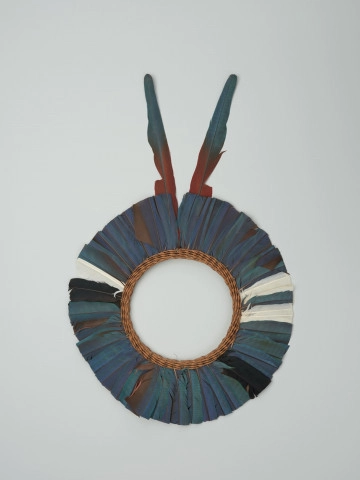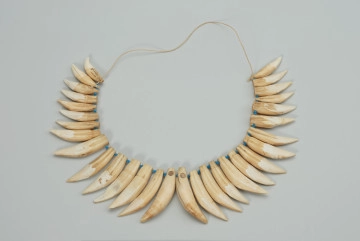
Bird feather epaulettes
około 1951 — 2000
National Museum in Szczecin
Part of the collection: Crafts of the Amazon Indians
The De'áruwa Indians are known in ethnological literature as Piaroa. They call themselves De'áruwa, which means 'people of the forest' or 'owners of the forest'. They live in the Orinoco basin, Amazonas state in Venezuela. Crowns made of bird feathers in Indian communities are traditionally reserved for men, essential personalities. The De'áruwa Indians believe that the crown is inspired by a magical power from which the shaman draws his strength, which is why he is the one who wears it. In the last few years, crowns made of bird feathers have been made by the Indians for sale or trade with Creoles. Their arts and crafts are also very popular with tourists. In each De'áruwa community, ruw'a is elected to represent the Indians in spiritual and political life. He is the shaman and also the head of the village. Sometimes this function is split between two men. Ruw'a should be tactful, emotionally stable and peaceful. The De'áruwa believe that these are the qualities of an ideal man. As the spiritual guide of the community, he should ensure its success and protect it from all dangers, especially supernatural ones. With his knowledge, he controls the invisible forces with which he contacts during trance. Indians believe that most diseases are the result of breaking food taboos. They never hunt or eat deer or tapir meat. In most groups, peccary is also tabooed. That is because they believe that the spirits of their ancestors live in these animals. According to them, every hunt and consumption of wild game can bring the risk of illness, which is caused by the guardian spirits of the animals. Only a shaman can cleanse the hunter and the hunted meat from the disease. Ruw'a sings meñe, a song whose words heal. He also contacts the helper spirits of tianawa, thanks to their intercession he can cure illness. Ruw'a is the trustee of the community's myths, legends, and history, which is why, until now, he has formally been the oldest member of the group. Nowadays, the old authorities are declining, and teachers, nurses, people from the government administration who have a good knowledge of Spanish and Venezuelan law are chosen as political leaders, so they are better able to fight for the community's interests.
Katarzyna Findlik-Gawron
Author / creator
Dimensions
cały obiekt: height: 75,6 cm, diameter: 30,2 cm
Object type
crown
Creation time / dating
Creation / finding place
Identification number
Location / status

unknown
około 1951 — 2000
National Museum in Szczecin

unknown
około 1980 — 1985
National Museum in Szczecin

unknown
około 1971
National Museum in Szczecin
DISCOVER this TOPIC
Castle Museum in Łańcut
DISCOVER this PATH
Educational path
0/500

We use cookies to make it easier for you to use our website and for statistical purposes. You can manage cookies by changing the settings of your web browser. More information in the Privacy Policy.
We use cookies to make it easier for you to use our website and for statistical purposes. You can manage cookies by changing the settings of your web browser. More information in the Privacy Policy.
Manage cookies:
This type of cookies is necessary for the website to function. You can change your browser settings to block them, but then the website will not work properly.
WYMAGANE
They are used to measure user engagement and generate statistics about the website to better understand how it is used. If you block this type of cookies, we will not be able to collect information about the use of the website and we will not be able to monitor its performance.